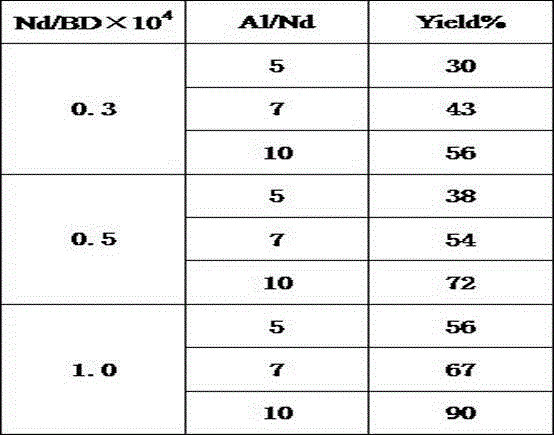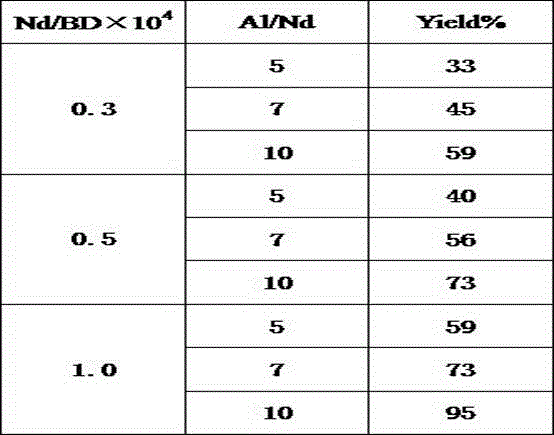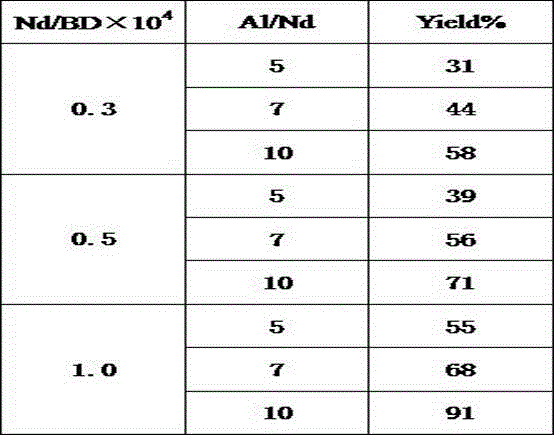A kind of method of synthesizing solution type rare earth rubber catalyst
A rare earth rubber and catalyst technology, applied in the field of synthesis of rare earth rubber catalysts, can solve problems such as poor fluidity, heterogeneity, disadvantages, etc., and achieve the effect of simple process and low cost
- Summary
- Abstract
- Description
- Claims
- Application Information
AI Technical Summary
Problems solved by technology
Method used
Image
Examples
Embodiment 1
[0023] Use neodymium trioxide and hydrochloric acid to prepare an aqueous solution of neodymium trichloride with a concentration of 1.14 mol / L; use hexane to prepare a solution of P507 with a concentration of 0.35 mol / L; use distilled water to prepare an aqueous solution of sodium hydroxide with a concentration of 4.97 mol / L.
[0024] Take 2 L of P507 hexane solution in a 10 L container, add 2 L of hexane, then add 140 mL of sodium hydroxide solution under stirring, and stir and react at 50°C for 30 min to obtain a saponified solution. Then 205 mL of neodymium trichloride solution was added, and the reaction was rapidly stirred at room temperature for 30 min, and 1 L of hexane was added when the reaction was carried out for 10 min. Neodymium organophosphate was formed during the reaction, and the solution became obviously viscous, and stratification occurred after the stirring was stopped. The upper layer was a slightly purple viscous substance, and the lower layer was a clear ...
Embodiment 2
[0027] Use neodymium trioxide and hydrochloric acid to prepare an aqueous solution of neodymium trichloride with a concentration of 1.14 mol / L; prepare a P204 solution with a concentration of 0.36 mol / L with hexane; prepare an aqueous solution of sodium hydroxide with a concentration of 4.97 mol / L with distilled water.
[0028] Take 2 L of P204 hexane solution in a 10 L container, add 2 L of hexane, then add 145 mL of sodium hydroxide solution under stirring, and stir and react at 50°C for 30 min to obtain a saponified solution. Then 210 mL of neodymium trichloride solution was added, and the reaction was stirred rapidly at room temperature for 30 min, and 1 L of hexane was added when the reaction was carried out for 10 min. Neodymium organophosphate was formed during the reaction, and the solution became obviously viscous, and stratification occurred after the stirring was stopped. The upper layer was a slightly purple viscous substance, and the lower layer was a clear and tra...
Embodiment 3
[0031] Use neodymium trioxide and hydrochloric acid to prepare an aqueous solution of neodymium trichloride with a concentration of 1.14 mol / L; use hexane to prepare a solution of P507 with a concentration of 0.35 mol / L; use distilled water to prepare an aqueous solution of sodium hydroxide with a concentration of 4.97 mol / L.
[0032] Take 2 L of P507 hexane solution in a 10 L container, add 1.65 L of hexane, then add 140 mL of sodium hydroxide solution under stirring, and stir and react at 50°C for 30 min to obtain a saponified solution. Then 205 mL of neodymium trichloride solution was added, and the reaction was rapidly stirred at room temperature for 30 min, and 1 L of hexane was added when the reaction was carried out for 10 min. Neodymium organophosphate was formed during the reaction, and the solution became obviously viscous, and stratification occurred after the stirring was stopped. The upper layer was a slightly purple viscous substance, and the lower layer was a cle...
PUM
 Login to View More
Login to View More Abstract
Description
Claims
Application Information
 Login to View More
Login to View More - R&D Engineer
- R&D Manager
- IP Professional
- Industry Leading Data Capabilities
- Powerful AI technology
- Patent DNA Extraction
Browse by: Latest US Patents, China's latest patents, Technical Efficacy Thesaurus, Application Domain, Technology Topic, Popular Technical Reports.
© 2024 PatSnap. All rights reserved.Legal|Privacy policy|Modern Slavery Act Transparency Statement|Sitemap|About US| Contact US: help@patsnap.com










